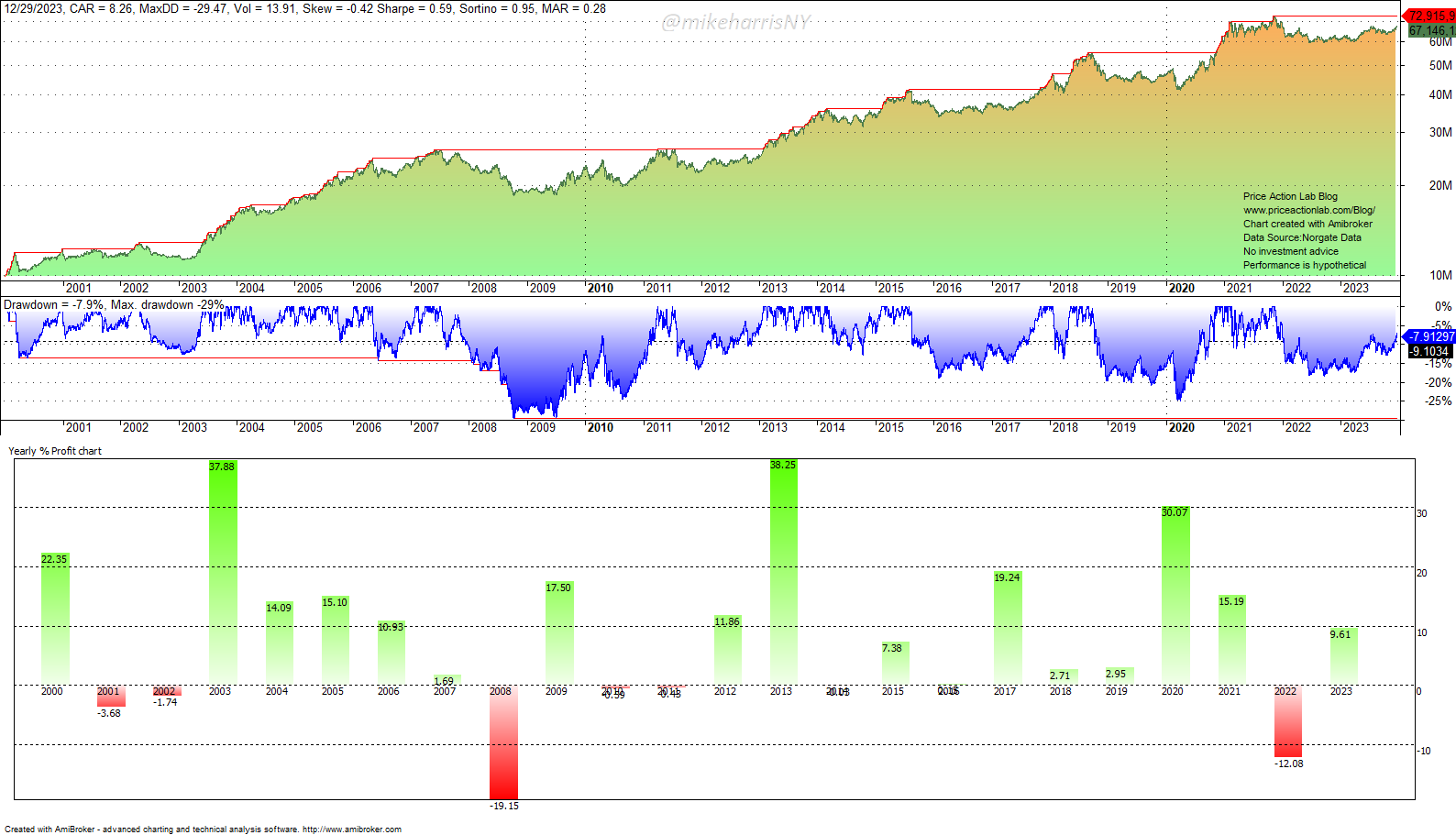Does trend-following work on stocks, especially on small-cap stocks? Many have misinterpreted answers to this question that have been offered in the past. In this article, we discuss some of the issues with trend-following small caps and present backtest results that we hope will contribute to the ongoing discussion.
What do people mean when they say, “Trend following does not work on stocks?” They do not mean trend-following fails to catch stock trends, but that performance is not that spectacular to justify abandoning strategic investing to transition to the more complicated and transaction-intensive trend-following style. In other words, there is no alpha, or the alpha is not large enough to justify a change in style.
However, trend-following small-caps could provide some convexity to a portfolio via lower volatility and a higher Sharpe ratio. This can also provide leveraged alpha. Before we present the results, we will list some issues with backtesting and trading small-caps strategies.
Backtesting issues
When backtesting stock trading strategies, it is important to account for delistings. In the case of small caps, in particular, not accounting for delistings yields random results, with the performance highly understated.
In addition, for those stocks that have been in the index for a long time, adjustments due to splits and dividends distort the series. Using adjusted data for stocks may affect the results of some strategies, depending on how the signals are generated. In the analysis to follow, we use breakouts and signals that are unaffected by future adjustments.
Another issue has to do with the maximum number of open positions allowed and the score used to select stocks in case of more signals. Briefly, we have found out that holding a maximum of 100 small-cap stocks is about the optimum, and after that, returns diminish due to excessive risk diversification.
Furthermore, the maximum level of “portfolio heat” allowed, i.e., the maximum percentage of portfolio equity risked at any given time in a cash account, is a critical parameter that affects performance. This number determines the risk per trade and, therefore, the position size. We do not use risk based on ATR because, contrary to its popularity for futures, this method can become problematic in the case of stocks and could lead to over-fitting. We use the time-tested fixed-risk percent method instead. We have found out that a 25% maximum “portfolio heat” is a reasonable number in the case of small caps.
Trading Issues
There are a host of trading issues that cause real results to diverge significantly from backtested ones. Slippage is a well-known factor. In addition, low liquidity, lending costs, and the inability to short stocks, especially during bear markets, can cause wide variations between backtested results and real performance. Here, we cannot account for all of these issues, and our objective is to answer the general question of whether trend-following works for small-cap stocks in theory only.
Backtest settings
For all backtests in this article, we used Norgate data that includes current and past constituents. We highly recommend this data service (we do not have a referral arrangement with the company).
Index: Russell 2000 (current and past constituents)
Strategy type: long-short (and reverse) trend-following based on breakouts.
Maximum open positions: 100
Price limit for shorting: > $20
Limit trade size: 5% of daily volume at entry
Backtest range: 01/03/2000 –12/29/2023
The exact rules of the strategy are available to Trend Following subscribers at the end of the article (protected content).
No commission, long and short
The annualized return is 8.3%, the maximum drawdown is 29.5%, and the Sharpe ratio is 0.59.
Short trades could provide some convexity during bear markets and large corrections, although the overall impact on performance is not significant. Without short trades, trend-following offers no major benefits over passive buy and hold. The long trades determine wealth growth, and the short trades provide convexity.
Conclusion
- Trend-following works in the case of small caps and can deliver alpha.
- Determining the best parameters to use for a specific strategy may be a daunting task.
- Several issues can adversely affect real trading performance as compared to backtests. Liquidity and commissions are two.
Trading strategy rules
The rules of this simple strategy are also available with a Trend-Following subscription.
Does trend-following work on stocks, especially on small-cap stocks? Many have misinterpreted answers to this question that have been offered in the past. In this article, we discuss some of the issues with trend-following small caps and present backtest results that we hope will contribute to the ongoing discussion . . .
|
This post is for paid subscribers
Already a subscriber? Sign in |
Click here for a list of strategies.
Disclaimer: No part of the analysis in this blog constitutes a trade recommendation. The past performance of any trading system or methodology is not necessarily indicative of future results. Read the full disclaimer here.
Charting and backtesting program: Amibroker. Data provider: Norgate Data
If you found this article interesting, you may follow this blog via RSS or Email, or on Twitter








